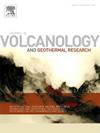从岩石显微结构推断,1783年日本浅间火山喷发期间普林尼柱从生长到崩塌的过渡
IF 2.3
3区 地球科学
Q2 GEOSCIENCES, MULTIDISCIPLINARY
Journal of Volcanology and Geothermal Research
Pub Date : 2025-03-04
DOI:10.1016/j.jvolgeores.2025.108310
引用次数: 0
摘要
1783年浅间火山喷发是日本中部最近的一次高震级爆发(VEI 4)。在高潮阶段,喷发由普林尼柱的形成过渡到火山碎屑密度流的产生。本研究确定了不同喷发类型火山碎屑沉积物的关键差异,显示了密度、孔隙度、气泡微观结构和含水量的变化。火山碎屑沉积被划分为14层浮石或火山灰,其中5层含有来自早期pdc的粉质火山灰。火山碎屑落落沉积被气候期生成的PDC沉积覆盖。与沉降浮石相比,PDC浮石的囊泡性和气泡连通性较低,但气泡较细,气泡数密度较高,岩浆减压速率较高。此外,根据地质体玻璃和晶体组成计算的岩浆温度和初始含水量在1783年喷发期间基本保持不变,而PDC浮石的地质体玻璃含水量较高,表明上升岩浆的溶解量减少。根据理论预测的水溶蚀引起的囊泡性变化,我们估计在高潮期普林尼期柱形成期间提供给羽流的初始含水量的质量分数为0.81 ~ 0.93,在PDC期提供给羽流的质量分数为0.68。供水的减少可能导致了喷发柱的不稳定,并导致了pdc的产生。本文章由计算机程序翻译,如有差异,请以英文原文为准。
Transition from growth to collapse of the Plinian column during the 1783 eruption of Asama volcano, Japan, inferred from rock microtextures
The 1783 eruption of Asama volcano was the most recent high-magnitude explosive eruption (VEI 4) in central Japan. During the climactic phase, the eruption transitioned from the formation of Plinian columns to the generation of pyroclastic density currents (PDCs). This study identified key differences in pyroclastic deposits across eruption styles, showing that changes in density, porosity, bubble microstructure, and water content. The pyroclastic fall deposits were divided into 14 layers of either pumice or ash, five of which contained silty ash derived from earlier PDCs. The pyroclastic fall deposits were overlain by PDC deposits generated in the climactic phase. Compared to fallout pumice, the PDC pumice had lower vesicularity and bubble connectivity but contained finer bubbles and high bubble number densities, suggesting higher magma decompression rates. Furthermore, the temperature and initial water content of the magma calculated from the compositions of the groundmass glasses and the crystals remained almost unchanged during the 1783 eruption, whereas the groundmass glass of the PDC pumice had a higher water content, indicating that the amount of water exsolved from the rising magma decreased. Based on theoretically predicted changes in vesicularity caused by water exsolution, we estimated that the mass fraction 0.81–0.93 of the initial water content was supplied to the plume during the formation of the climactic Plinian columns, and the mass fraction 0.68 during the PDC phase. The reduction in the water supply might have contributed to destabilizing the eruption column and caused the generation of PDCs.
求助全文
通过发布文献求助,成功后即可免费获取论文全文。
去求助
来源期刊
CiteScore
5.90
自引率
13.80%
发文量
183
审稿时长
19.7 weeks
期刊介绍:
An international research journal with focus on volcanic and geothermal processes and their impact on the environment and society.
Submission of papers covering the following aspects of volcanology and geothermal research are encouraged:
(1) Geological aspects of volcanic systems: volcano stratigraphy, structure and tectonic influence; eruptive history; evolution of volcanic landforms; eruption style and progress; dispersal patterns of lava and ash; analysis of real-time eruption observations.
(2) Geochemical and petrological aspects of volcanic rocks: magma genesis and evolution; crystallization; volatile compositions, solubility, and degassing; volcanic petrography and textural analysis.
(3) Hydrology, geochemistry and measurement of volcanic and hydrothermal fluids: volcanic gas emissions; fumaroles and springs; crater lakes; hydrothermal mineralization.
(4) Geophysical aspects of volcanic systems: physical properties of volcanic rocks and magmas; heat flow studies; volcano seismology, geodesy and remote sensing.
(5) Computational modeling and experimental simulation of magmatic and hydrothermal processes: eruption dynamics; magma transport and storage; plume dynamics and ash dispersal; lava flow dynamics; hydrothermal fluid flow; thermodynamics of aqueous fluids and melts.
(6) Volcano hazard and risk research: hazard zonation methodology, development of forecasting tools; assessment techniques for vulnerability and impact.

 求助内容:
求助内容: 应助结果提醒方式:
应助结果提醒方式:


